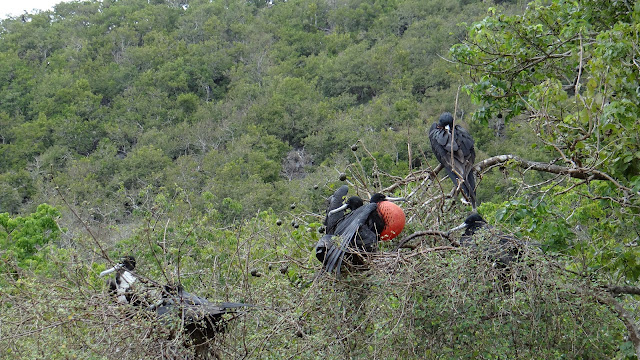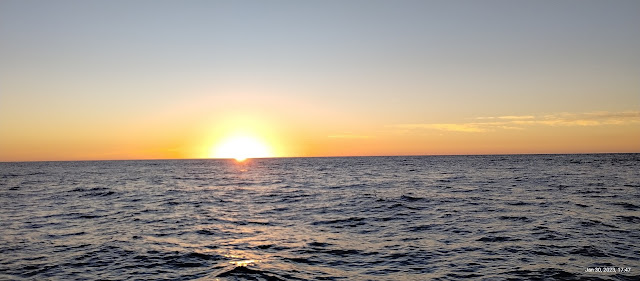Our First Passage: Mazatlán to Banderas Bay/La Cruz (Jan. 27 to Jan. 31st)
Trip Summary & Stats:
240 miles total; 58 hours travel time; Avg speed 4.1 mph; Max speed 7.1 mph.
 |
| John W. |
The swells out of Mazatlán were pretty big with a short period, so the boat was rocking and rolling. All 3 of us took sea sick meds called Sturgeon (works great and no drowsiness!) as a preventive measure, which worked like a charm. I saw a blow-hole spray of a whale off in the distance within the first 30 minutes of sailing - seeing whales will never get old!
Night Watch: We divided the night watch into 3 hour shifts so we could theoretically sleep 6 hours. I had the 9 to midnight shift and the 6:00 am shift, so I think I lucked out. There was no moon and it was dark! It's a bit freaky because you can start imagining that your seeing things, like a big wave on the horizon, but it's peaceful and cool at the same time. I was able to sleep a few hours and then woke up for my second "shift" starting at 6:00 am. I am not a morning person but it was nice seeing the sunrise and a pod of dolphins were swimming right next to the boat when I started my shift - totally made up for getting up early!
 |
| Sunrise! |
 |
| Isla Isabel |
Isla Isabel! (Jan. 28 93 miles from Mazatlán): We spotted Isla Isabel, our first anchorage, at about 8:00 am. Saw many whales swimming and breaching as we neared the island. Isla Isabel, known as the "Galapagos of Mexico" is an isolated island about 39 miles from San Blas and is inhabited seasonally by local fisherman. The island has hundreds, if not thousands, of nesting Magnificent Frigates and Blue footed Boobies. After we anchored on the eastern side of the island, we ate breakfast & took the dinghy ashore and went for a 2+ hour hike. The nesting birds, iguanas, and other reptiles were very cool to see. Launching the dinghy in the surf was challenging - especially when our old outboard was not starting - but after a few tries, Tom got it started and we didn't get too wet 😌
 |
| Two blue footed booby chicks - one chick is much larger than its sibling! |
 |
| Magnificent Frigate Chick |
 |
| Old research station and fishing camp |
Isla Isabel to San Blas Sunday, Jan. 29th (128 Miles from Mazatlán): We left Isla Isabel in the morning and had a beautiful sail to San Blas. We saw so many whales, which was great, but also a little nerve-wracking because you have to make sure you don't hit them - hitting a whale can severely damage & potentially sink your boat and hurt them as well. When the engine isn't running, they don't hear us when sailing so.....We anchored in the San Blas river across from the marina. It's a shallow narrow channel to enter with shifting sand bars so, as with most channels, you have to pay close attention to depths and navigation charts.
 |
| Anchored in the River |
San Blas is a small community first occupied by the Spaniards in the 1500's. In 1768, San Blas became the Pacific naval port for New Spain until it was abandoned for deeper water ports further south and areas that didn't have as many insects (San Blas is known for their no-see-ums & mosquitos, but we lucked out and didn't have insect issues 😊). The town, which is about 1/3 the size it once was in the 1700's, is very cute with a main square or plaza, a huge catholic church on the square, and cobble streets. A famous poem "The Bells of San Blas" was written by Henry Wadsworth Longfellow after the church bells were removed for some reasons in 1872. Maybe the bells were annoying...😉 |
| Restaurant in San Blas |

San Blas Eco\Jungle Tour Jan. 30: On Monday, John & I went on an Eco-Tour near San Blas (Tom had to work). Saw many birds and several new bird species for my life list, such as the Boat-billed Heron and the Rufous-bellied Chachalaca. The river & jungle were beautiful and full of life, including crocodiles!
 |
| First of several crocodiles spotted |
 |
| Boat-billed Heron |
 |
| Spring feeding the river |
San Blas to Chacala (145 miles from Mazatlán): Left San Blas in the early afternoon to head towards our last anchorage for our trip, Chacala. It was a nice day for sailing but also motored a bit as it got darker. We didn't get into the anchorage until after dark and left early Tuesday morning. It looks like a nice bay with several beach restaurants, so I'm looking forward to going back there on our way north.
Chacala to La Cruz/Banderas Bay! Jan 31 (188 miles from Mazatlán; Latitude 20 degrees 45' ): Left the anchorage at 7:00 am just after sunrise. Sailing was great in the morning but the winds died down and we had to motor the last half of the day. Banderas Bay is beautiful with huge mountains on the south side of the bay that seems densely forested. Puerto Vallarta is on the east side of the bay and it's one of the largest bays in Mexico. About 400 humpback whales migrate to Banderas Bay every winter to give birth and to breed. Other sea life, including sea turtles, manta rays, tuna, and dorado/mahi-mahi are fairly common too. We got into the La Cruz bay anchorage about 4:00 and took John W. to town via the dinghy. Had dinner and said good-bye/thanks to John. We anchored for 2 nights, replenished our fresh water tanks using our water maker, and got a slip in Marina Rivera Nayarit (aka La Cruz Marina) for a month so that we could do a few improvements to our boat before venturing on. Overall it was a great passage!
 |
| La Cruz Anchorage |





































Comments
Post a Comment